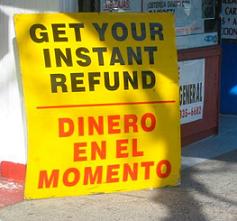U.S. banks not only pulled off a multi-billion dollar tax dodge, but they extracted millions of dollars straight from the tax refunds of the working poor.
Walk through any low income neighborhood during tax season, and you'll see storefronts papered with signs for "Rapid Refunds" and "Instant Money." These ads mask what tax preparers are truly peddling: usurious bank loans, at rates of 50% -- 500% APR, for which taxpayers sign over their IRS tax refunds -- including their Earned Income Tax Credits.
Known as tax refund anticipation loans (RALs), these loans became rampant in poor neighborhoods and communities of color in the 1990s.

RALs are a prime example of the blurring between so-called "mainstream" and "fringe" banking. Some of the largest U.S. banks -- including Chase and HSBC -- came to dominate the refund loan business, colluding with tax prep firms like H&R Block and Jackson Hewitt to siphon off people's tax refunds and federal EITC dollars.
Not surprisingly, RALs quickly became big business -- not just for banks and tax preparers, but for rent-to-own stores, check cashers, payday lenders and used car dealerships that all found ways to get a piece of the action.
At the RAL industry's peak, in 2004, low income taxpayers paid $1.24 billion in fees, for the privilege of borrowing their own money for just a few days.
Fast forward to 2011, and these predatory tax-time loans may soon be a thing of the past. Spurred by economic justice and consumer rights groups across the country, the feds have, it seems, cut the legs out from under the industry.
Last year, the IRS dealt a major setback to RAL providers by eliminating its "debt indicator" --which had allowed tax preparers and banks to see if people's refunds might be garnished to pay back taxes or other debts.
Soon after, the OCC, the national bank regulator, ordered HSBC -- previously the largest issuer of RALs -- to stop making the loans. Chase voluntarily got out of the market in early 2010. And in 2011, the FDIC ordered the handful of remaining state-chartered banks making RALs to exit the business.
NEDAP, like groups across the country, has long fought for an end to RALs. From mapping the millions of dollars leeched from NYC neighborhoods to testifying at public hearings, drafting model legislation, and organizing protests and street theater in front of Jackson Hewitt's headquarters, NEDAP has worked every angle we could find to expose the predatory nature of RALs, and to shine a light on the big banks and corporations at the heart of a seemingly fringe industry.
Tax refund loans are almost -- but not quite -- history, and groups like ours are wary of celebrating their demise prematurely. Kentucky-based Republic Bank, for example -- one of the last RAL banks standing -- is fighting the FDIC's order to exit the business. And regulators that have cracked down on RALs in recent years could change course under different leadership.
Most likely of all, tax preparers and banks will continue to find ways to take lucrative bites out of people's tax refunds. Undercover testers sent to commercial tax preparers in NYC this year were steered to other costly bank products, and gouged by tax prep fees -- $540 in one case, for a simple return that took less than an hour to prepare.
Ending the array of rip-offs that target the poor is a ways off. Putting the nail in the coffin of RALs is a good start.